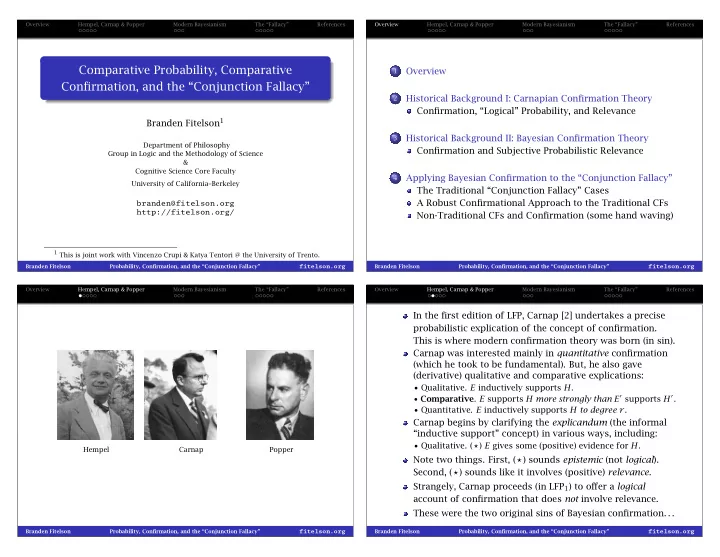

Overview Hempel, Carnap & Popper Modern Bayesianism The “Fallacy” References Overview Hempel, Carnap & Popper Modern Bayesianism The “Fallacy” References Comparative Probability, Comparative Overview 1 Confirmation, and the “Conjunction Fallacy” Historical Background I: Carnapian Confirmation Theory 2 Confirmation, “Logical” Probability, and Relevance Branden Fitelson 1 Historical Background II: Bayesian Confirmation Theory 3 Department of Philosophy Confirmation and Subjective Probabilistic Relevance Group in Logic and the Methodology of Science & Cognitive Science Core Faculty Applying Bayesian Confirmation to the “Conjunction Fallacy” 4 University of California–Berkeley The Traditional “Conjunction Fallacy” Cases A Robust Confirmational Approach to the Traditional CFs branden@fitelson.org http://fitelson.org/ Non-Traditional CFs and Confirmation (some hand waving) 1 This is joint work with Vincenzo Crupi & Katya Tentori @ the University of Trento. Branden Fitelson Probability, Confirmation, and the “Conjunction Fallacy” fitelson.org Branden Fitelson Probability, Confirmation, and the “Conjunction Fallacy” fitelson.org Overview Hempel, Carnap & Popper Modern Bayesianism The “Fallacy” References Overview Hempel, Carnap & Popper Modern Bayesianism The “Fallacy” References In the first edition of LFP, Carnap [2] undertakes a precise probabilistic explication of the concept of confirmation. This is where modern confirmation theory was born (in sin). Carnap was interested mainly in quantitative confirmation (which he took to be fundamental). But, he also gave (derivative) qualitative and comparative explications: • Qualitative. E inductively supports H . • Comparative . E supports H more strongly than E ′ supports H ′ . • Quantitative. E inductively supports H to degree r . Carnap begins by clarifying the explicandum (the informal “inductive support” concept) in various ways, including: • Qualitative. ( ⋆ ) E gives some (positive) evidence for H . Hempel Carnap Popper Note two things. First, ( ⋆ ) sounds epistemic (not logical ). Second, ( ⋆ ) sounds like it involves (positive) relevance . Strangely, Carnap proceeds (in LFP 1 ) to offer a logical account of confirmation that does not involve relevance. These were the two original sins of Bayesian confirmation. . . Branden Fitelson Probability, Confirmation, and the “Conjunction Fallacy” fitelson.org Branden Fitelson Probability, Confirmation, and the “Conjunction Fallacy” fitelson.org
Overview Hempel, Carnap & Popper Modern Bayesianism The “Fallacy” References Overview Hempel, Carnap & Popper Modern Bayesianism The “Fallacy” References In the 1st ed. of LFP, Carnap characterizes “the degree to In LFP 1 , Carnap describes a counterexample to Hempel’s which E confirms H ” as c (H, E) = Pr (H | E) , which leads to: (SCC), which presupposes a more ( ⋆ )-like qualitative Quantitative. Pr (H | E) = r . conception of confirmation. There, he presupposes: Comparative . Pr (H | E) > Pr (H ′ | E ′ ) . Qualitative. E confirms H iff Pr (H | E) > Pr (H) . Qualitative. Pr (H | E) > t (typically, with “threshold” t > 1 2 ). This probabilistic relevance conception violates (SCC), Doesn’t sound like ( ⋆ ). More on this dissonance below. whereas the previous Pr-threshold conception implies (SCC). Like Hempel [7], Carnap wanted a logical explication of Popper [12] notes this tension in LFP. Largely in response to confirmation (as a relation between sentences in FO L s). Popper, Carnap wrote a second edition of LFP [3], which For Carnap, this meant that the probability functions used includes a preface acknowledging an “ ambiguity ” in LFP 1 : in confirmation theory must themselves be “logical”. Firmness . The degree to which E confirms f H : This leads naturally to the Carnapian project of providing a c f (H, E) = Pr (H | E) . “logical explication” of conditional probability Pr ( · | · ) itself . Increase in Firmness . The degree to which E confirms i H : Here, Carnap was strongly influenced by Keynes [10], who c i (H, E) = f [ Pr (H | E), Pr (H)] believed there were (probabilistic) “partial entailments”. I’m f measures “the degree to which E increases the Pr of H .” somewhat skeptical (as are most modern Bayesians). The 1st ed. of LFP was mainly about firmness, and the 2nd Hempel’s theory of confirmation [7] satisfies the following: edition only adds the preface, which says very little about (SCC) If E confirms H , then E confirms all consequences of H . c i . Specifically, no function f is rigorously defended there. Branden Fitelson Probability, Confirmation, and the “Conjunction Fallacy” fitelson.org Branden Fitelson Probability, Confirmation, and the “Conjunction Fallacy” fitelson.org Overview Hempel, Carnap & Popper Modern Bayesianism The “Fallacy” References Overview Hempel, Carnap & Popper Modern Bayesianism The “Fallacy” References c i is more similar to ( ∗ ) than c f is. To see this, note that we can have Pr (H | E) > t even if E lowers the probability of H . Example: Let H be the hypothesis that John does not have HIV, and let E be a positive test result for HIV from a highly reliable test. Plausibly, in such cases, we could have both: Pr (H | E) > t , for just about any threshold value t , but Pr (H | E) < Pr (H) , since E lowers the probability of H . So, if we adopt Carnap’s c f -explication, then we must say that E confirms H in such cases. But, in ( ∗ )-terms, this implies E provides some positive evidential support for H ! I take it we don’t want to say that . Intuitively, what we want Isaac Levi Jim Joyce to say here is that, while H is (still) highly probable given E , (nonetheless) E provides (strong!) evidence against H . Carnap [3] seems to appreciate this dissonance, when he concedes c i is (in some settings) “more interesting” than c f . Contemporary Bayesians would agree with this. They’ve since embraced a probabilistic relevance conception [13]. Branden Fitelson Probability, Confirmation, and the “Conjunction Fallacy” fitelson.org Branden Fitelson Probability, Confirmation, and the “Conjunction Fallacy” fitelson.org
Recommend
More recommend